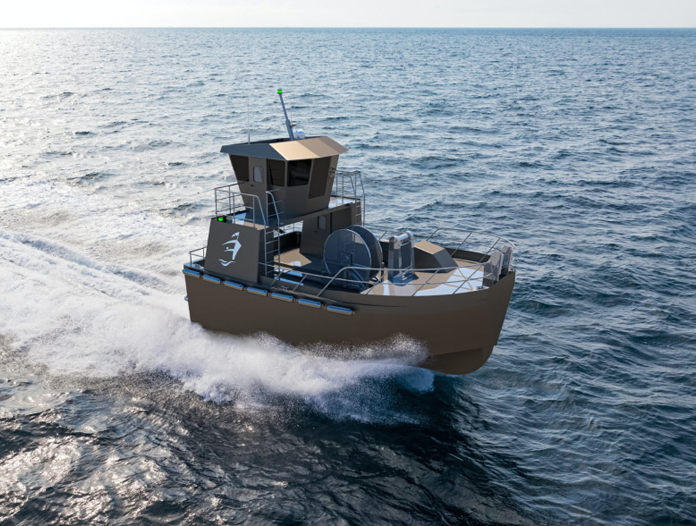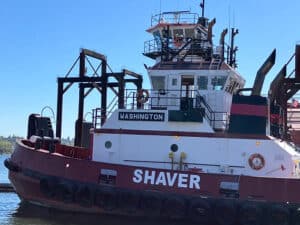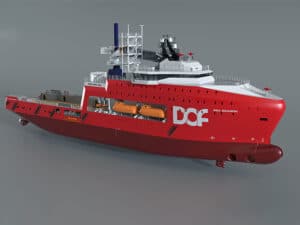
New commercial fishing vessels are needs-tailored
Written by
The 32- by 20-foot gillnetter is capable of making 20 knots with a 20,000-pound capacity. (Credit: Elliott Bay Design Group)
By Jonathan Hawes
When it comes to commercial fishing vessels, innovations often amount to greater efficiency of the operation, and because of that, they bring much more profit. So, some recent changes to commercial fishing vessel designs are likely to be very good indicators of where some parts of the sector are headed.
These innovations are mostly focused on the power of the vessel, usability of it by its crew, and streamlining fishing operations.
GUTSY BRISTOL BAY GILLNETTER DESIGNED
A new compact commercial fishing vessel is meant for general use, but designed for conditions of the particular fishery of Bristol Bay, Alaska.
Elliott Bay Design Group’s (EBDG) new 32-foot gillnetter is an ultra-shallow, triple-jet boat created for the very shallow waters of Bristol Bay (less than 20-feet); and with the bay’s currents and tides and 32-foot boat length limitation in mind. It can do 20 knots, and has a 20,000-pound fish capacity.
The model’s design—short, but stocky and hardy in profile—may set it apart from other vessels working in the very active Bristol Bay fishery, which is one of the bright spots of Alaska’s fisheries.
Originally unveiled in late 2019, the new boat design is meant to enable the vessel to have powerful enough systems to be the first back to the dock. In Bristol Bay, a limited-entry fishery (with just 1,800 permits), being able to do 20 knots to unload is a game changer. It means succeeding in one of the very best fisheries in Alaska, where good fishing conditions have actually been improving over the past few years.
“The boat’s design allows for a good combination of power and weight,” said David Turner, a project manager for EBDG, who worked on the boat’s design team.
The design really was an outgrowth of increasingly profitable conditions for fishermen in Bristol Bay and the need for a better boat to serve that particular fishery, whose success has drawn interest throughout the commercial fishing sector.
“We’ve been paying attention to the Bristol Bay fishery’s success,” Turner said. “There’s a lot going on up there.”
This new vessel design is the product of a partnership between EBDG and Cummins, who collaborated on creating the design.
“It was a kind of a joint marketing effort,” Turner said. “Our intent is that we will do the naval architecture, and the electronics, engines and jets will be tailored to the owner’s needs.”
The project wasn’t the first on which the two companies have collaborated. But in this case, the vessel design grew out of a discussion in late 2018 between Turner and Mike Fourtner, a commercial marine salesman for Cummins, who also happens to be a part-time commercial fisherman who fishes Bristol Bay and is very familiar with the fishery.
“We just started talking,” Fourtner recalled, noting that the brisk business of the fishery sparked the conversation. “For the last six or seven years the hottest market in Alaska has been Bristol Bay. It’s been the bright spot.”
Fourtner should know about those conditions; he’s been on a boat working in commercial fishing since he was nine, and hasn’t spent a July 4 onshore since he was younger than that. He loves the work, considering his fishing in Bristol Bay to be the perfect de-stressing time.
“I own my own boat, but sell marine engines for Cummins,” Fourtner said. “I work for Cummins full-time, but I also commercial fish in Bristol Bay. The evolution of that fishery is that it has grown, first, from using sailboats, to 1,200-hp twin jet boats, now. You’re challenged by tides and currents there differently than in any other fishery. … I wanted Elliott Bay to design a concept for those ready to go the 20 foot wide, stable platform.”
The Bristol Bay market has been exceptionally hot over the past three years. In 2021, the overall salmon run there was 65 million pounds, with an escapement of 25 million pounds. Alaska Fish and Game Commission predicts an even better season for next year for Bristol Bay.
Among commercial fishermen, it’s a bit of a mystery what’s going on with Bristol Bay—why things have been so good there recently when they haven’t been as good elsewhere. Pros say it seems to be due to a combination of factors, including good fishery management, and also the unique ecosystem of the bay.
“So many of my fisherman friends want to know what’s going on with Bristol Bay,” Fourtner said. “Why does it have massive salmon returns compared to other places?”
Which brings the story back to the obvious need for innovation in vessels fishing Bristol Bay; new needs bring change. You fish where the fish are, and there are an increasing number of them in the bay, driving a need for greater speed and other changes in boat designs.
“The only reason I suggested [to Turner] looking at a boat like this with Elliott Bay” was existing demand, Fourtner said. “Cummins has many engines on order for Bristol Bay—52 are on order now. We’re hoping people will want this next evolution [of vessel], because we believe this is where Bristol Bay is headed.”
MODERNIZED TRAWLER UPGRADES ADDED
In another innovative corporate partnership, EBDG is helping the O’Hara Corporation modernize its 204-foot factory trawler, Alaska Spirit. Originally an offshore supply vessel built in 1974, the boat has been fishing Alaska’s Bering Sea since 1989. At that time it was converted from an offshore supply vessel, into a head and gut factory trawler.
O’Hara Corporation’s multi-year revamp of the vessel is a complete overhaul. The work is meant to improve its habitability, operational efficiency, and overall vessel performance. The modernization work, which is ongoing, has been done during normal down time, with no fishing seasons missed.
Upgrades have included replacement of the pilothouse port lights with windows, a new generator and hydraulic engines, conversion of underutilized aft tanks to stores, a new factory, habitability upgrades, and redesign of the trawl deck. EBDG has provided engineering support for the project.
The ship’s crew quarters also have been upgraded, including modernized staterooms, laundry, shower, and toilet spaces. The galley and mess area also are currently being upgraded. The project also has added silencers to the exhaust lines of all diesel engines, decreasing onboard noise.




